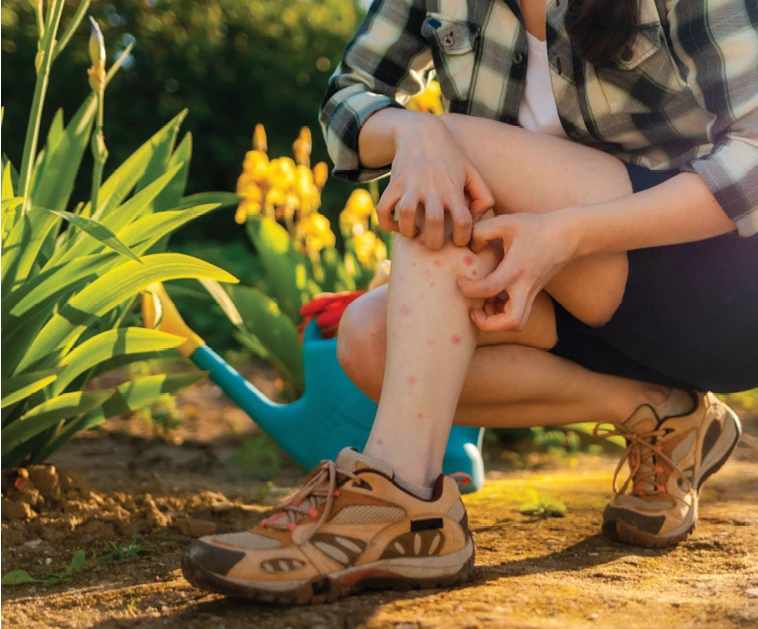|
Apart from your customers’ lawns, the disease is an important concern for golf course superintendents across the country. In fact, that’s where the disease got its common name: On golf greens, symptoms of dollar spot appear as small, circular, sunken, patches of tan-colored grass. The spots are often the size of an American dollar coin; hence the term “dollar spot.”
Spots may combine, creating large, irregular, bleached areas. Typical leaf blade symptoms commence as water-soaked spots that turn straw-colored with reddish-brown margins. The reddish-brown banding does not occur on annual bluegrass. The spots may form distinctive “hourglass” shaped lesions on individual blades as the lesion is often narrower in width than the leaf. In the landscape, leaf spot symptoms are more noticeable on taller mowed Kentucky bluegrass and perennial ryegrass species. When heavy dew is present in the early morning, white cobwebby threads of the fungus may be seen in affected spots. As the air warms and the turf dries, the fungal threads may not be visible. Turf in these heavily infected spots may be killed. The presence of white aerial hyphae may be confused with other fungal diseases such as Pythium blight, Nigrospora blight and brown patch. Infected spots are sometimes also mistaken for red thread, although the mycelium of this fungus is pinkish-red in color. Environment. The primary methods of dispersal are mowers and maintenance equipment, although shoes, wind and rain may also spread the disease. Environmental conditions of high relative humidity and extended periods of leaf wetness either from rain or irrigation provide conditions for the disease to develop. The disease infection occurs between 59-86oF. However, the optimal temperature for infection of fungal biotypes varies greatly with different geographic locations. Other environmental conditions that favor disease development include: low nitrogen fertility, dry soils and high moisture canopy conditions.
Aerify soil to reduce plant stress from compaction and thatch accumulation. Careful attention to irrigation practices is highly recommended. Irrigate soil to a depth of 4-6 inches, preferably in the morning or early evening to reduce prolonged periods of leaf wetness. Fungi need moisture in order to infect leaves. When dollar spot is active, apply light and frequent amounts of nitrogen to reduce disease severity. In home lawns, raising the mowing height can stimulate growth and subsequent recovery. Sponsored Content Lawn and Landscape Marketing on a BudgetDigital marketing can feel overwhelming when you’re working with a limited budget. Websites, SEO, social media, and paid ads can quickly add up, but you don’t need to do everything to see results. By focusing on cost-effective strategies, you can still make a big impact without overspending. Chemical Control. The most satisfactory results can be achieved when products are applied early in disease development. To avoid the development of fungicide-resistant biotypes of the pathogen, rotate chemical classes of fungicides and follow label directions. Consult with regional turf specialists and professionals for advice on which products have the best efficacy for your geographical area.
|
Get curated news on YOUR industry.
Enter your email to receive our newsletters.
Explore the April 2011 Issue
Check out more from this issue and find your next story to read.
Latest from Lawn & Landscape
- EnP Investments adds Mark McCarel as Northeast territory sales manager
- Our April issue is now live
- Ready or not
- Tribute to an industry guru
- Caterpillar names Christy Pambianchi as chief human resources officer
- Ceramica acquires Fundraising Brick
- Senske Family of Companies acquires Huron Pest Control
- Sunseeker unveils new X7 Series Robotic Mowers

 Dollar spot is an economically significant fungal pathogen caused by Sclerotinia homoeocarpa. The disease occurs on nearly all cultivars of cool and warm season turfgrass species worldwide.
Dollar spot is an economically significant fungal pathogen caused by Sclerotinia homoeocarpa. The disease occurs on nearly all cultivars of cool and warm season turfgrass species worldwide.






